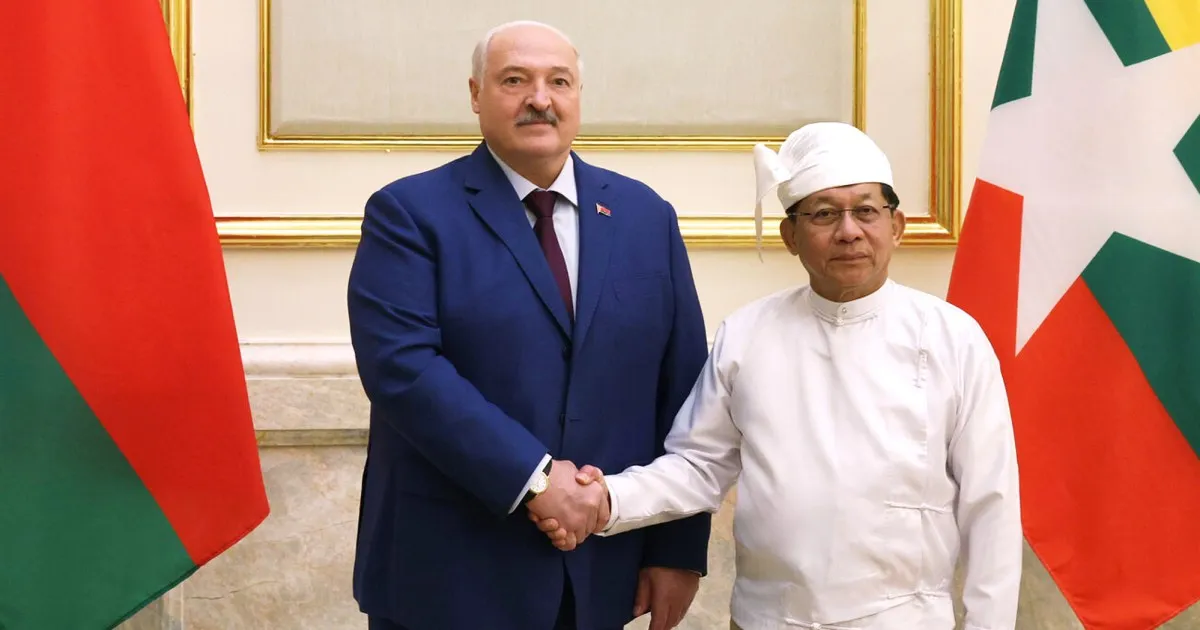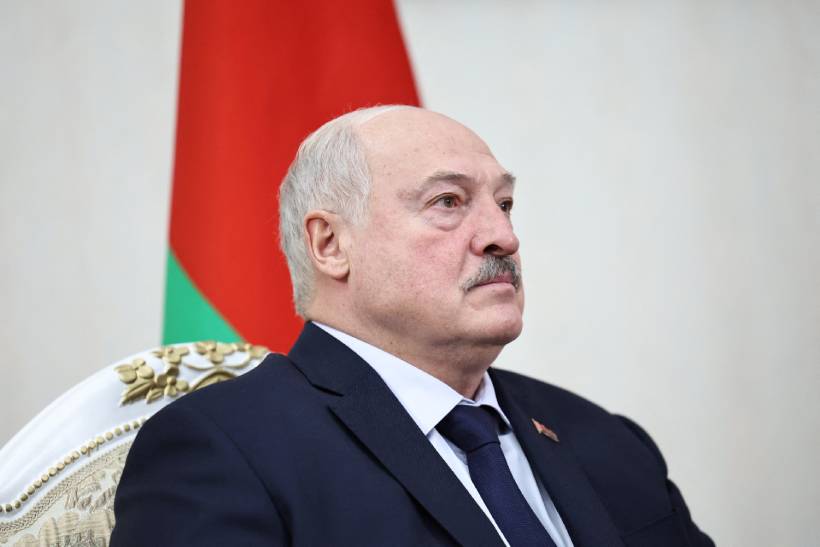Belarusian President Alexander Lukashenko recently announced his intention to pay an official visit to Myanmar. Under other circumstances, this visit might have gone unnoticed, but amid the Myanmar crisis, every visit by a foreign leader to Naypyidaw attracts attention. According to Lukashenko, the trip will be part of a larger international tour that will also include Oman, Algeria, and Kyrgyzstan. The two leaders have already met four times in 2025: during Myanmar President Senior General Min Aung Hlaing’s visit to Minsk in March, during Victory Day celebrations in Moscow in May, during the Eurasian Economic Forum in June, and at the PLA parade in Beijing in September. This is a reciprocal visit intended to strengthen relations between Belarus and Myanmar.
The signing of 18 agreements in various fields is planned, including the mutual waiver of tourist visas, a cooperation agreement between the Myanmar Space Agency and the National Academy of Sciences of Belarus, an agreement on mutual legal assistance, and so on. Expect Myanmar opposition media to talk about Belarusian educational programs for Tatmadaw (Myanmar’s armed forces) officers and the supply of Belarusian UAVs. For now, all of this fits the “pariah in arms” pattern: the familiar cooperation of two regimes suffering from sanctions pressure and accused of human rights violations. But could something more lie behind Lukashenko’s visit? And can Myanmar’s military leadership learn lessons from its Belarusian partner’s strategy? Let’s discuss the less obvious aspects of Myanmar-Belarus relations.
Lukashenko is often portrayed as a Russian proxy, but in practice, Belarusian politics is quite complex. A charismatic former collective farm director, Lukashenko came to power in the 1994 presidential election. His victory came amid a wave of nostalgia for the USSR that swept Belarusian society, which was facing the costs of establishing a free market: declining production, rising prices, rampant crime, and a profoundly uncertain future. At the time, the relatively young populist boldly criticized the nomenklatura, which the people had grown tired of.
At the same time, Lukashenko clearly declared himself a supporter of integration with Russia and an opponent of Belarusian pro-Western nationalism. He kept his promises: the population became more socially secure, organized crime groups were defeated, and the trend toward forced “Belarus-ization” was halted (most ethnic Belarusians prefer to communicate in Russian in everyday life and are skeptical of the opposition’s calls to switch to Belarusian).
At the same time, Lukashenko has always staunchly defended the independence of the Belarusian state and has sometimes even clashed with Moscow. In the 2000s, high-profile “energy wars” erupted between Minsk and Moscow. In 2006, after the Russian state-owned company Gazprom revoked preferential terms for oil supplies to Belarus, the outraged Belarusian leadership retaliated: it imposed additional duties on the transit of Russian oil and began pumping oil from the pipeline. Moscow was forced to back down.
In 2010, Russia demanded that Lukashenko pay off its natural gas debts, after which Lukashenko reminded Russia of its own debts. A series of anti-Lukashenko propaganda films was shown on Russian television. The conflict was resolved through mutual debt repayment, but Minsk could claim victory by upholding its strategic autonomy in the post-Soviet space. In his campaign against Gazprom, the Belarusian leader stoked anti-oligarchic sentiment in Russia and, as a result, gained popularity among the left-wing opposition. For a long time, dreams of a merger between Russia and Belarus were popular among this group, with Lukashenko being tipped as the president of the union state. Among older Russians nostalgic for the Soviet era, Lukashenko rivaled Putin in approval ratings.
“Multi-vectorism” has become the hallmark of Belarusian foreign policy. Minsk has responded to the growing tensions between Russia and the EU/USA head-on, maintaining contacts with all stakeholders. During the first phase of the Russian-Ukrainian conflict in 2014-2020, Lukashenko ambitiously positioned Belarus as a neutral “Slavic” platform for Russian-Ukrainian negotiations. A Belarusian diplomatic triumph was the adoption of agreements in Minsk in 2014-2015, involving not only Russia and Ukraine, but also Germany and France. At the same time, despite his Russophile rhetoric, Lukashenko continued to sell diesel fuel (produced from Russian oil!) to the Ukrainian armed forces.
Lukashenko immersed himself in multi-vector diplomacy and overlooked the changing mood of Belarusian society – people were growing tired of the uncontested leader. Conviction that the 2020 presidential election results had been rigged brought people out onto the streets; mass protests engulfed the country, forcing Lukashenko to make temporary concessions, only to later unleash an avalanche of brutal repression on the protesters.
It was at this time, amid the threat of revolution and moral condemnation from the West, that Minsk decided to move closer to Moscow. However, domestically, Belarusian propaganda, in addition to the standard accusations against the US and EU of supporting the opposition, declared the protests a “Russian oligarchs’ plot to overthrow the legitimate president.” Even in a situation where only Moscow could ensure Lukashenko’s continued power, he preferred to retain the freedom to maneuver in his own interests.
Contacts between Washington and Minsk continue, and Trump’s team appears to be closer to mutual understanding with the Belarusians than with the Russians (the Belarusian president personally meets Americans and invariably ends negotiations with a vodka-fueled feast). At the same time, Belarus’s active diplomacy in the post-Soviet space is noteworthy, where Minsk is particularly friendly with Azerbaijan (despite its clashes with Moscow) and the countries of Central Asia. Beijing is also emphatically lenient in its relations with Lukashenko, who emphasizes that, unlike other former Soviet countries, Belarus has retained a reverence for its communist legacy.
The Belarusian multi-vector model for Naypyidaw
Lukashenko arrives in Naypyitaw at a time when the Myanmar government is desperate for international recognition. It’s hard to say whether the Myanmar generals ever considered using their Belarusian partner as a go-between to establish ties with Trump’s team. However, this approach clearly seems preferable to multi-million dollar investments in American lobbying firms, which have so far yielded no results. A new round of talks on Ukraine involving Belarus will take place in December, and Myanmar could very well use this opportunity to use Lukashenko to generate positive interest in the White House.
Beyond the short-term benefits of friendship with Minsk, Myanmar could learn from Belarus the art of multi-vector foreign policy. The configuration of Russian-Belarusian relations is reminiscent of China-Myanmar relations: both Belarus and Myanmar are “small nations” located within the sphere of influence of their larger neighbors, Russia and China, but at the same time striving for strategic autonomy. Chinese infrastructure projects in Myanmar, in particular the oil and natural gas pipeline from Yunnan Province to the port of Kyaukphyu in Rakhine State, designed to provide China with access to the Indian Ocean, can be compared to Russian energy infrastructure in Belarus (the Druzhba pipeline). Minsk can act as a senior mentor to Naypyidaw in defending its energy independence from China.
Stabilizing Myanmar Based on the Belarusian Experience: Pros and Cons
There are vast differences between Myanmar and Belarus – in history, traditions, religion, and ethnic composition. Nevertheless, Naypyidaw could borrow some Belarusian wisdom not only in foreign policy but also in domestic policy.
Mass protests in Belarus in 2020 were sparked by obvious vote rigging in favor of Lukashenko. Paradoxically, the 2020 elections in Myanmar were held under the majoritarian system adopted in Belarus and resulted in a constitutional transfer of power in favor of the military due to electoral fraud by the NLD. The political regimes of Myanmar and Belarus have different backgrounds and structures: the populist Lukashenko is more reminiscent of Aung San Suu Kyi, while the Belarusian army lacks independence and is incapable of military coups. But most importantly, Minsk and Naypyidaw are united by common challenges: internal instability fueled from abroad. Significantly, NUG representatives are simultaneously establishing contacts with the Belarusian government-in-exile of Svetlana Tikhanovskaya.
Lukashenko successfully overcame the critical moments of the 2020-2021 crisis and, at the cost of systematic human rights violations—something he had done before, by the way—defeated the opposition. What’s interesting here is not the moral aspect of the issue, but the regime’s survival strategy. Lukashenko alternately used carrots and sticks, and alongside repression, he recruited media opposition figures. A well-known example is that of radical opponent of the regime Roman Protasevich, who, after his unexpected arrest, found common ground with the regime and became its sincere defender. This demonstrates the potential for the Myanmar government to exploit loyal elements of the former NLD and even members of the NUG and PDF who agreed to cooperate with the regime.
On the other hand, it should be remembered that in a number of respects, the Myanmar regime is more lenient than the Belarusian one: several large-scale amnesties for political crimes were carried out by the “junta” without prior agreements with the United States. Lukashenko released several dozen of his opponents with guarantees that sanctions would be lifted; the Myanmar military has released thousands of far more dangerous convicts, guided not only by political expediency but also by the Buddhist ideal of compassion (there is no contradiction here, as Buddhism underlies realpolitik in Myanmar). This ideal is widely accepted by all Burmese, regardless of their views on current politics. Unlike the Belarusians, who underwent the brainwashing of communist atheism in the 20th century and practically lost their national identity, the Burmese have preserved their traditional culture, religion, and language and are able to resist the dual pressures of the West and China.
Conclusion
Learning from the Belarusian experience, Myanmar’s foreign policy is returning to its usual course. Long before independent Belarus appeared on the world map in 1991, Myanmar had already pursued a multi-vector policy. It is significant that even when relations with China’s Maoist regime deteriorated to the lowest point in the 1960s, due to Beijing’s support for the Communist Party of Burma (CPB), Ne Win’s government refrained from entering into anti-Chinese alliances with the United States or the USSR. This was a far-sighted decision. To a certain extent, modern Belarus could become Myanmar’s equivalent of Yugoslavia during the Cold War: both under U Nu’s democratic system and under Ne Win’s military dictatorship, the neutralist diplomacy of Titoism was admired.
While Republican and Democratic representatives repeat stereotypical misconceptions about Myanmar learned from Burmese exiles, the generals are gradually bringing the country out of isolation. The most important thing for the Myanmar people to remember is that their nation, the heir to ancient Buddhist kingdoms, has never been and never will be in the service of external powers: the Americans, the Chinese, the Russians, or anyone else. Lukashenko’s visit provides an opportunity to creatively develop the potential of Myanmar diplomacy.


